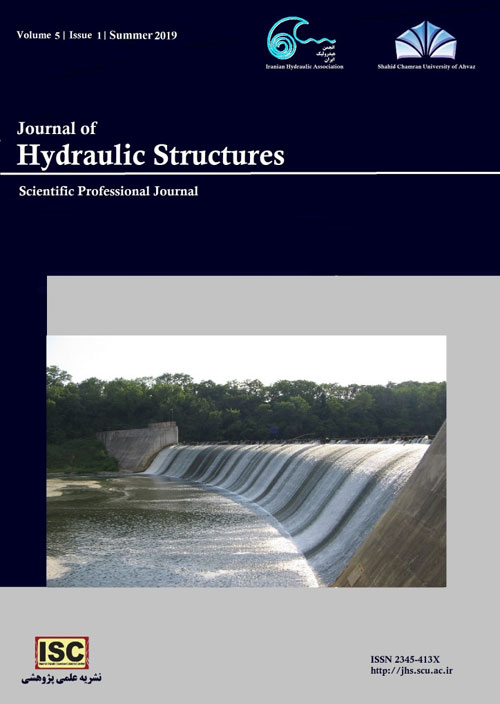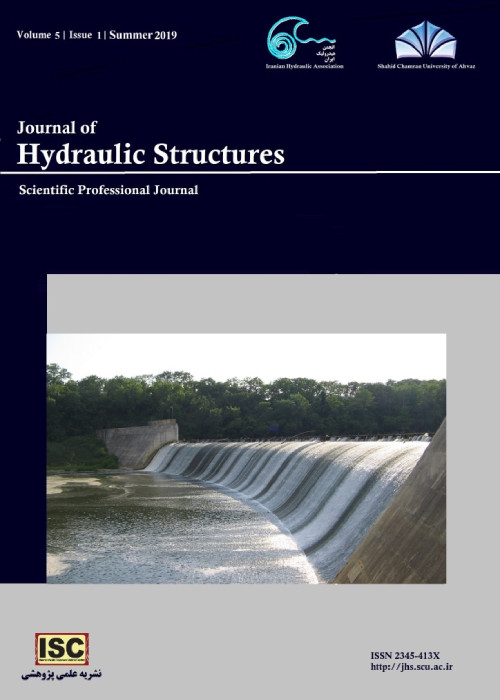فهرست مطالب

Journal of Hydraulic Structures
Volume:6 Issue: 3, Summer 2020
- تاریخ انتشار: 1399/06/11
- تعداد عناوین: 6
-
-
Pages 1-20The application of optimization tools and techniques to operate the reservoir on a Multi-objective basis under the circumstances of climate change is unavoidable. The present study utilizes the Multi-Objective Farmland Fertility Optimization (MOFFA) algorithm to derive optimum rules on the operation of the Golestan Dam in Golestan province under circumstances of climate change. The two targets of reducing vulnerability as well as maximizing reliability under baseline conditions (from April 2006 to October 2018) and climate change conditions (from April 2021 to October 2033) have been formulated for such guidelines. Results revealed that under climate change circumstances, the river flow decreased by 0.17 percent of the baseline period, although the temperature was increased by 20% as well as the rainfall decreased by 21.1%. However, the extent of vulnerability variations in baseline and climate change was 16-45% and 10-43%, respectively. The range of reliability variations in baseline and climate change circumstances was 47-90% and 27-93%. The vulnerability has also been measured at 29 percent and 27 percent for baseline and climate change, respectively, with 75 percent reliability. The increase in release rates for climate change in comparison with baseline circumstances and higher modification of release rates from the reservoir to demand and stronger dam efficiency in changing circumstances showed the comparison of releases and the water shortage requirements for each of Pareto points.Keywords: climate change, Decision Making Rules, Farmland Fertility Optimization Algorithm, Reliability, Vulnerability
-
Pages 21-44The importance of the proper implementation of the Groundwater Revival Plan (GRP) as one of the key approvals of the Supreme Water Council has been doubled due to the escalation of the groundwater crisis in most of Iran's aquifers. Therefore, the implementation of GRP principles is the only way to overcome the crisis and the related challenges. In this study, the management crisis of Iran's groundwater resources is re-evaluated from the perspective of the administrative, social, and legal system with the GRP challenging approach. Then, the best -worst fuzzy multi - criteria decision model in Lingo9 software is developed by collecting the opinions of 23 GRP experts, based on three general criteria of change in administrative structure (C1), policy structure (C2) and modification of GRP legal structure (C3), which includes 18 sub-criteria. The results showed that timely and appropriate allocation of financial resources (S22), creating incentive packages for farmers to improve the cultivation pattern (S23) and creating serious efforts at all levels of management in the field of implementation, continuity, and removal of obstacles (S21) respectively with weights. 0.2247, 0.1098, and 0.0946 - with more than 40% of the total importance - occupy the first to third ranks.Keywords: Groundwater Revival Plan, Best - Worst Fuzzy Multi Criteria Decision Model, Water resources management
-
Pages 45-58
Completion of the project in due time at the predefined quality and cost is of the most important concern. Along with the increase of duration of project implementation, the total cost of the project will be raised due to annual inflation and other introduced costs. This research has investigated and identifies the most important causes of damage occurrences and time delay, then prioritized them throughout the project cycle from the pre-construction phase up to the end of the commissioning phase. Besides, solutions to prevent these damages and resolving the challenges ahead have been developed. Thus, a list of data from literature and field surveys have been gathered. After brain storming in experts panel and collecting data; data has been analyzed through Analytical Hierarchy Process utilizing the Expert Choice 11 software, which has resulted in seven major delay factors including: deficit budget allocation (27%), economic problems of the country (24%), the weakness of contractor's site management (13%), use of not qualified personnel in construction management (11%), delay in preparing and lots of mistakes/ modifications in detail design by the consultant (10%), inaccurate proposal in tenders by the contractor (8%), and improper selection of the contractor by the client (7%). The expert panel considers that the budget allocation is the most important cause of damage to project. Finally, damage causing factors have also been classified into six effective factors as project team, client, management consultancy, engineering consultant, contractor, and uncontrollable factors such as political, economic and social factors.
Keywords: Causes of Delays, Dam, Analytical Hierarchy Process (AHP), Construction Management -
Pages 59-82The optimization of structure shapes is a challenging endeavor in many fields of engineering since the generation of a parametrical model and numerical solutions of the model in the optimization process may have heavy computational costs. In the present study, a methodology is presented for the design of shape optimization of high arch dams to simultaneously reduce dam construction costs and increase the dam body safety by considering stage construction. Structural optimization is performed for permanents loads, including dam body weight and the hydrostatic pressure of the reservoir water. To simulate concreting, the dam body weight is considered through an eight-stage loading. The Simultaneous Perturbation Stochastic Approximation (SPSA) optimization algorithm is employed to find the optimized shape using the simple additive weighting method. The VIKOR method is used to decide upon the optimized shape of the dam. The proposed methodology greatly assists analysts with little experience in designing. It also helps decide upon the preferred solution from among optimal solutions.Keywords: Double curvature concrete arch dam, Multi-objective Shape Optimization, Pareto Front VIKOR, Sum weighted SPSA Algorithm
-
Pages 83-91One of the environmentally-friendly solutions to meeting energy consumption is multi-reservoir hydropower systems. The operation of a multi-reservoir hydropower system is an entirely complex problem due to a wide range of decision variables. Classic algorithms often get stuck in the local optimum and cannot successfully address these problems. Modern algorithms are more effective than classic ones, although their computational time is very high. In this study, an innovative hybrid model is proposed, called cellular automata-tabu search (CA-TS) to optimally operate multi-reservoir systems. For simplification, CA divides the problem into several sub-problems, which the number of them is the same as the length of operation period. Each sub-problem is solved by TS so that the net benefit of the power generation is maximized. For comparison purpose, a non-linear four-reservoir benchmark problem is considered to evaluate the proposed method. Finally, the results are compared with the existing results obtained by GA, PSO, and CA-NLP, showing the efficiency of CA-TS.Keywords: Tabu search, Optimization, Hydropower operation, Cellular automata
-
Pages 92-107
This study presents a novel approach for real-time flood control by optimizing operation of a reservoir during the flood. However, the fundamental operational challenge of using this method is to determine optimized decisions of the reservoir management before the occurrence of flood, and optimal use of the pre-release to reduce the flood damages. In addition to this optimization challenge, since the timely forecasts are derived by employing the probabilistic methods, they would always associate with uncertainty. As a result, quantifying and considering these uncertainties in the flood control would result in reducing the risk of flood damage that can be evaluated by minimizing the expected value of the damage. Timely and continuous forecasting of inflow and reservoir operation management will be implemented before the occurrence of flood until it ends. In order to address the above challenges, a novel simulation-optimization methodology, by taking into account uncertainty, is developed; and illustrated on a case study of Dez reservoir, as a highly important reservoir system in south-west of Iran, to optimize the performance of this reservoir, during the floods. Accordingly, a new water resource management has been proposed and tested. The results derived from the proposed method, indicate a significant reduction in the peak release from the reservoir and the improved operation of the Dez reservoir in controlling the flood at real-time, which will reduce damages in the downstream area.
Keywords: Real-time flood control, Optimization of reservoir operation, Uncertainty quantification, Expected flood damage


